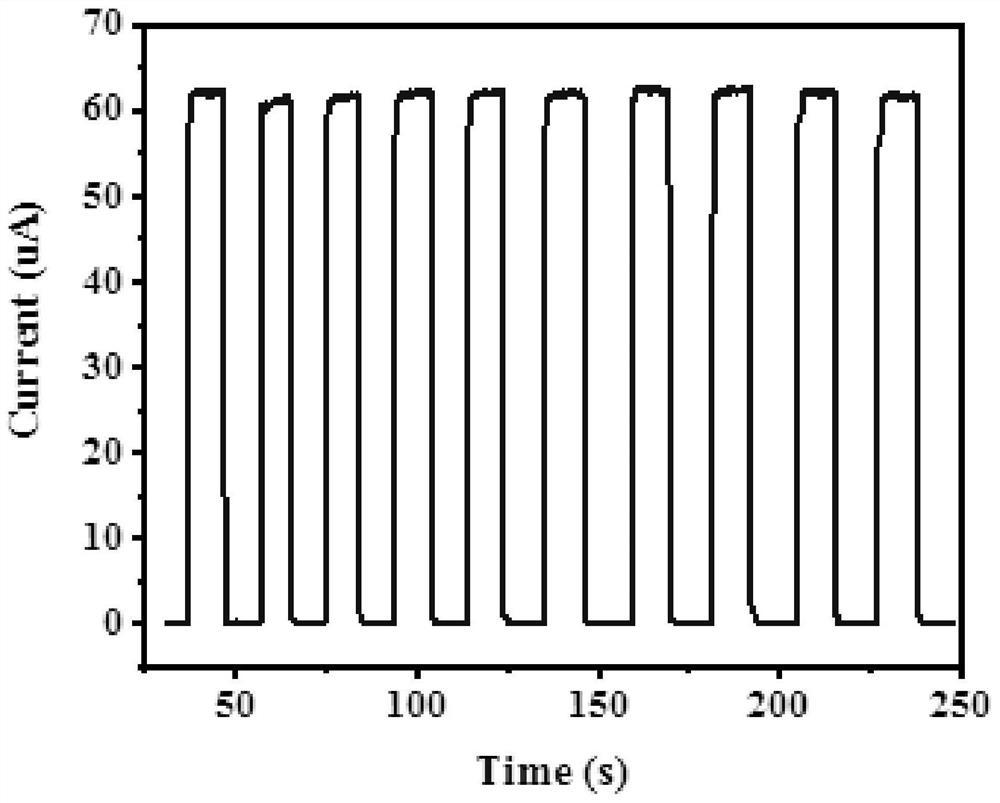Near-infrared light response spring-shaped photoelectric detector for silk fibroin detection
A near-infrared photoresponse, photodetector technology, applied in the field of photoelectrochemical sensing, can solve the problems of mass spectrometry measurement error, complex composition, cumbersome and other problems, and achieve short diffusion distance, high carrier mobility, and increased dispersion. Effect
- Summary
- Abstract
- Description
- Claims
- Application Information
AI Technical Summary
Problems solved by technology
Method used
Image
Examples
Embodiment 1
[0036] Step 1: Extraction of silk fibroin: Dissolve 1 g of silkworm cocoons in 100 ml of 0.5% Na 2 CO 3 Boil in aqueous solution for 30 min, then rinse with distilled water for 3 times to completely remove sericin; dry the degummed silk fibers in a drying oven at 50 °C for 24 h; mix the dried silk fibroin fibers with 100 ml of calcium chloride at 98 °C Dissolve in the solution (the molar ratio of calcium chloride, ethanol and distilled water is 1:2:8) for 1.5h; use a dialysis bag (molecular weight cut-off, MWCO: 8000) to dialyze the dissolved mixed solution 10 times, and replace it every 3h Distilled water once; use a centrifuge (6000 r / min) to purify the obtained solution; finally take the supernatant to freeze-dry and grind to obtain silk fibroin.
[0037] Step 2: H-TiO 2 Preparation of nanoparticles: the pure TiO 2 Nanoparticles were annealed in a tube furnace at 550 °C with a mixture of hydrogen and argon (1:1 by volume) for 2 h to obtain H-TiO 2 Nanoparticles are avai...
Embodiment 2
[0046] Step 1: Extraction of silk fibroin: Dissolve 2 g silkworm cocoons in 110 ml of 0.5% Na 2 CO 3 Boil in aqueous solution for 35 min, then rinse with distilled water for 4 times to completely remove sericin; dry the degummed silk fibers in a drying oven at 55 °C for 27 h; dry the dried silk fibroin fibers in 100 ml calcium chloride at 98 °C Dissolve in the mixed solution (the molar ratio of calcium chloride, ethanol and distilled water is 1:2:8) for 1.5 h; use a dialysis bag (molecular weight cut-off, MWCO: 8000) to dialyze the dissolved mixed solution 13 times, every 3.5 h Replace distilled water once; use a centrifuge (7000 r / min) to purify the obtained solution; finally take the supernatant, freeze-dry, grind, and obtain silk fibroin.
[0047] Step 2: H-TiO 2 Preparation of nanoparticles: the pure TiO 2 Nanoparticles were annealed in a tube furnace at 550 °C with a mixture of hydrogen and argon (1:1 by volume) for 2 h to obtain H-TiO 2 Nanoparticles are available fo...
Embodiment 3
[0055] Step 1: Extraction of silk fibroin: Dissolve 3 g silkworm cocoons in 120 ml 0.5% Na 2 CO 3 Boil in aqueous solution for 40 min, then rinse with distilled water for 5 times to completely remove sericin; dry the degummed silk fibers in a drying oven at 60 °C for 30 h; dry the dried silk fibroin fibers in 100 ml calcium chloride at 98 °C Dissolve in the mixed solution (the molar ratio of calcium chloride, ethanol and distilled water is 1:2:8) for 2 h; use a dialysis bag (molecular weight cut-off, MWCO: 8000) to dialyze the dissolved mixed solution for 15 times, every 4 h Replace the distilled water once; use a centrifuge (8000 r / min) to purify the obtained solution; finally take the supernatant, freeze-dry, and grind to obtain silk fibroin.
[0056] Step 2: H-TiO 2 Preparation of nanoparticles: the pure TiO 2 Nanoparticles were annealed in a tube furnace at 550 °C with a mixture of hydrogen and argon (1:1 by volume) for 2.5 h to obtain H-TiO 2 Nanoparticles are availab...
PUM
 Login to View More
Login to View More Abstract
Description
Claims
Application Information
 Login to View More
Login to View More - R&D
- Intellectual Property
- Life Sciences
- Materials
- Tech Scout
- Unparalleled Data Quality
- Higher Quality Content
- 60% Fewer Hallucinations
Browse by: Latest US Patents, China's latest patents, Technical Efficacy Thesaurus, Application Domain, Technology Topic, Popular Technical Reports.
© 2025 PatSnap. All rights reserved.Legal|Privacy policy|Modern Slavery Act Transparency Statement|Sitemap|About US| Contact US: help@patsnap.com

